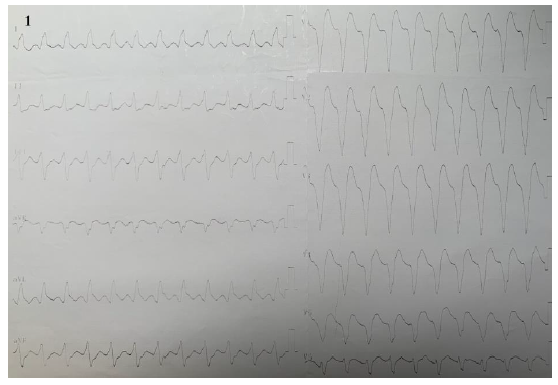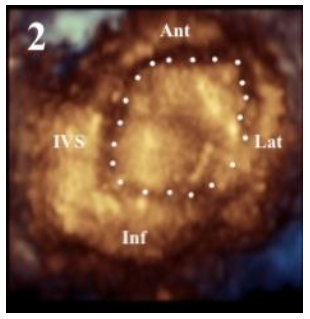Curative Treatment of Electrical Storm in a Patient with Apical Aneurysm and Thrombus: Aneurysmectomy
Mehmet Rasih Sonsoz*, Ahmet Kaya Bilge, Ali Elitok
Department of Cardiology, Istanbul University, Istanbul Faculty of Medicine, Istanbul, Turkey
*Corresponding Authors: Mehmet Rasih Sonsoz, Department of Cardiology, Istanbul University, Istanbul Faculty of Medicine, Turgut Ozal Street, No:118, Fatih, Istanbul, Turkey
Received: 07 October 2019; Accepted: 23 October 2019; Published: 31 October 2019
Article Information
Citation: Mehmet Rasih Sonsoz, Ahmet Kaya Bilge, Ali Elitok. Curative Treatment of Electrical Storm in a Patient with Apical Aneurysm and Thrombus: Aneurysmectomy. Journal of Surgery and Research 2 (2019): 258-260.
View / Download Pdf Share at FacebookKeywords
Aneurysmectomy, Catheter ablation, Electrical storm, ICD shocks, Thrombus, Ventricular tachycardia
Aneurysmectomy articles, Catheter ablation articles, Electrical storm articles, ICD shocks articles, Thrombus articles, Ventricular tachycardia articles
Aneurysmectomy articles Aneurysmectomy Research articles Aneurysmectomy review articles Aneurysmectomy PubMed articles Aneurysmectomy PubMed Central articles Aneurysmectomy 2023 articles Aneurysmectomy 2024 articles Aneurysmectomy Scopus articles Aneurysmectomy impact factor journals Aneurysmectomy Scopus journals Aneurysmectomy PubMed journals Aneurysmectomy medical journals Aneurysmectomy free journals Aneurysmectomy best journals Aneurysmectomy top journals Aneurysmectomy free medical journals Aneurysmectomy famous journals Aneurysmectomy Google Scholar indexed journals Catheter ablation articles Catheter ablation Research articles Catheter ablation review articles Catheter ablation PubMed articles Catheter ablation PubMed Central articles Catheter ablation 2023 articles Catheter ablation 2024 articles Catheter ablation Scopus articles Catheter ablation impact factor journals Catheter ablation Scopus journals Catheter ablation PubMed journals Catheter ablation medical journals Catheter ablation free journals Catheter ablation best journals Catheter ablation top journals Catheter ablation free medical journals Catheter ablation famous journals Catheter ablation Google Scholar indexed journals Electrical storm articles Electrical storm Research articles Electrical storm review articles Electrical storm PubMed articles Electrical storm PubMed Central articles Electrical storm 2023 articles Electrical storm 2024 articles Electrical storm Scopus articles Electrical storm impact factor journals Electrical storm Scopus journals Electrical storm PubMed journals Electrical storm medical journals Electrical storm free journals Electrical storm best journals Electrical storm top journals Electrical storm free medical journals Electrical storm famous journals Electrical storm Google Scholar indexed journals ICD shocks articles ICD shocks Research articles ICD shocks review articles ICD shocks PubMed articles ICD shocks PubMed Central articles ICD shocks 2023 articles ICD shocks 2024 articles ICD shocks Scopus articles ICD shocks impact factor journals ICD shocks Scopus journals ICD shocks PubMed journals ICD shocks medical journals ICD shocks free journals ICD shocks best journals ICD shocks top journals ICD shocks free medical journals ICD shocks famous journals ICD shocks Google Scholar indexed journals Thrombus articles Thrombus Research articles Thrombus review articles Thrombus PubMed articles Thrombus PubMed Central articles Thrombus 2023 articles Thrombus 2024 articles Thrombus Scopus articles Thrombus impact factor journals Thrombus Scopus journals Thrombus PubMed journals Thrombus medical journals Thrombus free journals Thrombus best journals Thrombus top journals Thrombus free medical journals Thrombus famous journals Thrombus Google Scholar indexed journals Ventricular tachycardia articles Ventricular tachycardia Research articles Ventricular tachycardia review articles Ventricular tachycardia PubMed articles Ventricular tachycardia PubMed Central articles Ventricular tachycardia 2023 articles Ventricular tachycardia 2024 articles Ventricular tachycardia Scopus articles Ventricular tachycardia impact factor journals Ventricular tachycardia Scopus journals Ventricular tachycardia PubMed journals Ventricular tachycardia medical journals Ventricular tachycardia free journals Ventricular tachycardia best journals Ventricular tachycardia top journals Ventricular tachycardia free medical journals Ventricular tachycardia famous journals Ventricular tachycardia Google Scholar indexed journals Apical Aneurysm articles Apical Aneurysm Research articles Apical Aneurysm review articles Apical Aneurysm PubMed articles Apical Aneurysm PubMed Central articles Apical Aneurysm 2023 articles Apical Aneurysm 2024 articles Apical Aneurysm Scopus articles Apical Aneurysm impact factor journals Apical Aneurysm Scopus journals Apical Aneurysm PubMed journals Apical Aneurysm medical journals Apical Aneurysm free journals Apical Aneurysm best journals Apical Aneurysm top journals Apical Aneurysm free medical journals Apical Aneurysm famous journals Apical Aneurysm Google Scholar indexed journals intracardiac echocardiography articles intracardiac echocardiography Research articles intracardiac echocardiography review articles intracardiac echocardiography PubMed articles intracardiac echocardiography PubMed Central articles intracardiac echocardiography 2023 articles intracardiac echocardiography 2024 articles intracardiac echocardiography Scopus articles intracardiac echocardiography impact factor journals intracardiac echocardiography Scopus journals intracardiac echocardiography PubMed journals intracardiac echocardiography medical journals intracardiac echocardiography free journals intracardiac echocardiography best journals intracardiac echocardiography top journals intracardiac echocardiography free medical journals intracardiac echocardiography famous journals intracardiac echocardiography Google Scholar indexed journals
Article Details
Abbreviations:
ICD-Intracardiac cardioverter defibrillator; VT-Ventricular tachycardia
1. Introduction
Left ventricular aneursym is a well-known late complication after myocardial infarction and these patients are at risk for developing ventricular tachycardia which involves the infarct scar. Although it is often amenable to pace termination from ICD, it can lead to electrical storm which may require catheter ablation of the exit sites. However, the procedure has the risk of systemic embolism especially if a ventricular thrombus is present. Herein, we report the management of a young gentleman with incessant monomorphic ventricular tachycardia who had ventricular aneursym and thrombus.
2. Case Report
A 41-year-old gentleman was admitted to the hospital with the diagnosis of anterior myocardial infarction in October 2015. A coronary angiography revealed a total occlusion in proximal LAD segment. The operator performed predilatation and successfully implanted a drug eluting stent into the lesion. After several months, the patient developed dizziness and palpitations, and he was diagnosed with having sustained monomorphic ventricular tachycardia (Figure 1), which was treated with electrical cardioversion. Transthoracic echocardiography disclosed moderate left ventricular systolic dysfunction, left ventricular apical aneurysm and 3 × 3 cm mural thrombus in aneurysm, which was confirmed with 3D echocardiography (Figure 2). Warfarin was added to treatment. For secondary prevention, a VVI-R ICD was implanted in our institution in January 2016.

Figure 1: Electrocardiogram demonstrating monomorphic ventricular tachycardia with a rate of 171 bpm/min. The negative concordance in precordial derivations reflects the apical origin of the arrhythmia.
Ant: anterior wall; inf: inferior wall; IVS: interventricular septum; lat: lateral wall

Figure 2: 3D echocardiographic photo demonstrating thrombus image (surrounded by dots) in lumen of apical aneurysm.
Until April 2016, he received many times appropriate shocks due to VT, which made him develop suicidal thoughts. We could manage the electrical storm neither with antiarrhythmic therapy nor with cardioversion. We evaluated the chance for a successful catheter ablation, however the embolic risk far outweighed the benefit because of persisting apical mural thrombus. Therefore, we planned urgent aneurysmectomy in order to control the electrical storm. After the successful surgery, the episodes of ventricular tachycardia diminished and apical mural thrombus disappeared. The patient is now in well condition, and no ICD shocks have been observed since 2016.
3. Discussion
This case denotes that surgery may be a curative alternative to catheter ablation in a patient with incessant VT and apical thrombus. Cardiac surgery for VT is rarely performed, but has a role in highly symptomatic patients, when antiarrhythmic medications and catheter ablation fails or are not possible [1]. Although Peichl et al. [2] reported successful catheter ablation in patients with concomitant left ventricular thrombus, we didn’t have the chance to use intracardiac echocardiography. Aneurysmectomy provided both cessation of electrical storm and removal of left ventricular thrombus in our case.
Acknowledgments
We thank Dr. Ömer Say?n performing the surgery.
Declarations of Interest
None
Funding
This research did not receive any specific grant from funding agencies in the public, commercial, or not-for-profit sectors.
References
- Al-Khatib SM, Stevenson WG, Ackerman MJ, et al. 2017 AHA/ACC/HRS Guideline for Management of Patients With Ventricular Arrhythmias and the Prevention of Sudden Cardiac Death. Circulation 138 (2018): 272-391.
- Peichl P, Wichterle D, Cihak R, et al. Catheter Ablation of Ventricular Tachycardia in the Presence of an Old Endocavitary Thrombus Guided by Intracardiac Echocardiography. Pacing Clin Electrophysiol 39 (2016): 581-587.


 Impact Factor: * 4.2
Impact Factor: * 4.2 Acceptance Rate: 72.62%
Acceptance Rate: 72.62%  Time to first decision: 10.4 days
Time to first decision: 10.4 days  Time from article received to acceptance: 2-3 weeks
Time from article received to acceptance: 2-3 weeks 